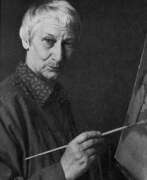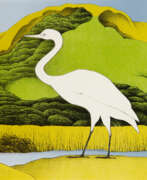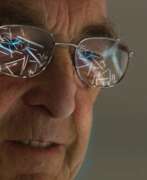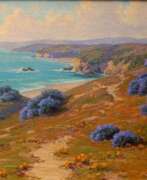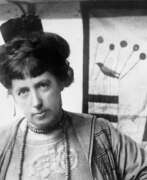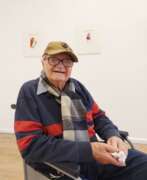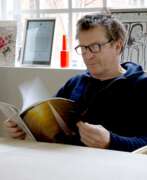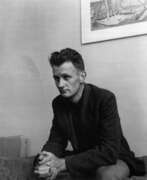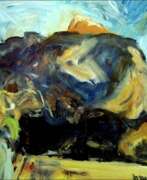New Zealand
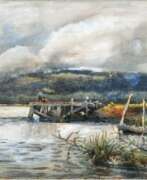

Arthur Merric Boyd was an Australian painter. He and his wife Emma Minnie (née à Beckett) established a lifestyle of being artists which many generations followed to create the popular image of the Boyd family. Boyd travelled and painted a good deal on the continent of Europe, and returned to Australia about the end of 1893, where he lived mostly in Sandringham and other suburbs of Melbourne for the rest of his life. He occasionally sent good work to the exhibitions of the Victorian Artists' Society, but never mixed much in the artistic life of his time.


Simon Denny is a contemporary artist from New Zealand, born in 1982. He works with a variety of media including sculpture, installation, video, and printmaking. Denny's work often explores the intersection of technology, politics, and economics. He is particularly interested in how technological systems shape our lives and societies. In his art, he frequently uses images and objects related to the tech industry, such as circuit boards, computer servers, and software interfaces. One of Denny's most well-known works is "Secret Power," which was exhibited at the 2015 Venice Biennale. The installation focused on the activities of the Government Communications Security Bureau (GCSB), New Zealand's intelligence agency. It included a recreation of the agency's boardroom, as well as a series of prints and sculptures that explored the agency's role in global surveillance. Denny has exhibited his work internationally, including at the Museum of Modern Art (MoMA) in New York, the Serpentine Gallery in London, and the Biennale of Sydney. In 2019, he was awarded the prestigious Ars Viva Prize for Visual Arts.
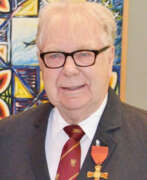

Maxwell Harold Gimblett is a New Zealand and American artist. His work, a harmonious postwar synthesis of American and Japanese art, brings together abstract expressionism, modernism, spiritual abstraction, and Zen calligraphy. In 2006 he was appointed Inaugural Visiting Professor at the National Institute of Creative Arts and Industries, Auckland University. Gimblett has received honorary doctorates from Waikato University and the Auckland University of Technology and was awarded the Officer of the New Zealand Order of Merit.
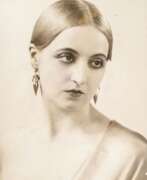

Eileen Rosemary Mayo was an English artist and designer who worked in England, Australia and New Zealand in almost every available medium — drawings, woodcuts, lithographs on stone and tempera, tapestry and silk screening. In addition to being a printmaker, illustrator, calligrapher and muralist, she designed coins, stamps, tapestry and posters, and wrote and illustrated eight books on natural science.


John Douglas Perrett, a New Zealand artist, was known for his oil paintings on canvas, focusing on the lakes and mountains of the South Island. He studied at the Glasgow School of Art and later established the Otago Art Academy in Dunedin. Perrett relocated to Auckland in 1895 and exhibited his work in various art societies and international exhibitions.
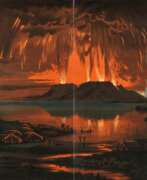

William Potts was a New Zealand artist and lithographer.
He is known as the author of illustrations for The History of New Zealand and Descriptions of its Cities and Towns.... and the Natural Wonders of New Zealand" (1889), which was edited by the noted politician Edward Gibbon Wakefield. Most impressive in this series of prints is the last color chromolithograph, which depicts on a large scale the 1886 eruption of the Taraweera volcano near Rotorua on the North Island, one of the deadliest natural disasters ever to befall New Zealand.
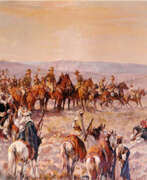

Harold Septimus Power, usually known as H. Septimus Power or H. S. Power, was a New Zealand-born Australian artist, who was an official war artist for Australia in World War I. He exhibited in 1899 with the Melbourne Art Club and soon after moved to Adelaide where he worked as an illustrator and political cartoonist. In 1904, he was commissioned by the trustees of the Art Gallery of South Australia to paint an animal scene. He was a member of the Royal Institute of Oil Painters and the Society of Animal Painters. He also exhibited at the Royal Academy of Arts. After war broke out in the summer of 1914, the Australian government appointed official war artists to depict the activities of the Australian Imperial Force in the European theater of war. Power was appointed in 1917 and was attached to the 1st Division, A.I.F. from September to December of that year and then again in August the following year. Official War Artist during the First World War and was renowned for his depiction of animals, in particular horses, on the field of battle.
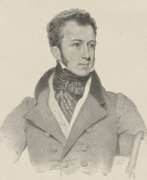

Edward Gibbon Wakefield was a politician, economist, writer and one of the British masterminds behind the colonization of Australia.
Edward was born into a respected Wakefield family in London, received a good education and served in the British Foreign Office. However, he was convicted for a marriage adventure and, sitting in prison, thought out a policy of colonization of Australia and New Zealand. In 1929, Wakefield published "An Outline of a Proposal for the Colonization of Australasia" and then published "A Letter from Sydney: the Chief City of Australia" on behalf of a certain expert on Australia. He proposed a scheme now sometimes called the Wakefield Scheme: it was aimed at settling the new colony of South Australia with able-bodied laborers, traders, artisans, and representatives of capital. It was to be financed by the sale of land to capitalists, who would thereby support other classes of emigrants. The colony was founded on December 28, 1836.
Wakefield was also the inspiration for the Durham Report (1839) on Canadian colonial policy. Wakefield subsequently created the blueprint for the Church of England settlement, Canterbury, on the South Island of New Zealand. From 1847 to 1850 the bulk of the "Canterbury Pilgrims" emigrated there, and in 1853 Wakefield became a member of the New Zealand General Assembly.


